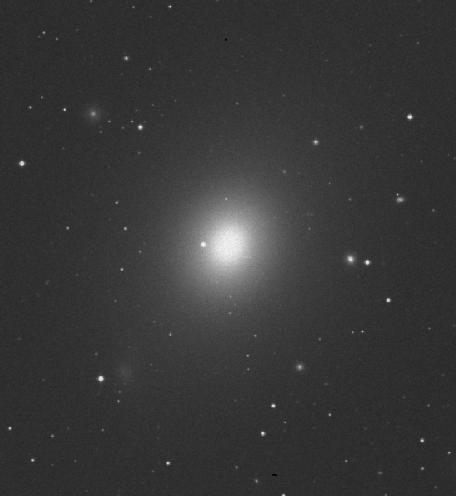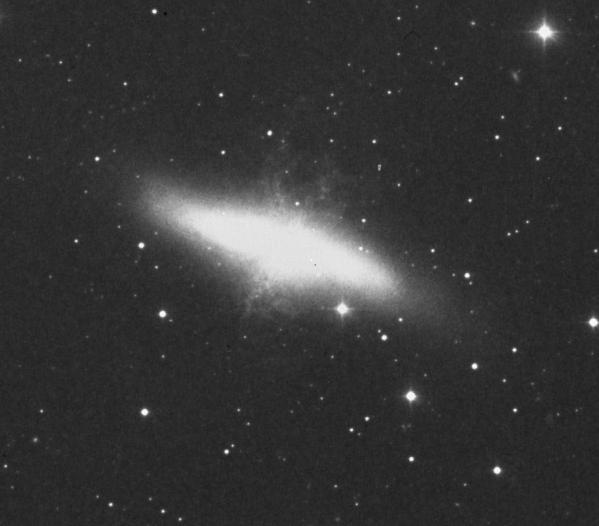1) Formation of galaxies
2) Measurements to the Galaxies
3) Types of Galaxies and
properties
4) Classes of Galaxies
5) Quasars
6) Dark Matter
- Most cosmologists believe that the galaxies that we observe today grew gravitationally out of small fluctuations (10-5) in the nearly uniform density of the early universe.
- These fluctuations leave an imprint in the cosmic microwave background radiation in the form of temperature fluctuations from point to point across the sky.
- The Big Bang theory can account for the existence of the cosmic microwave background radiation and explain the origin of the light elements, it does not explain the existence of galaxies and large-scale structure.
- The solution of the structure problem must be built into the framework of the Big Bang theory.
- Most cosmologists believe that the galaxies that we observe today
grew gravitationally out of small fluctuations in the density of the universe
through the following sequence of events:
- When the universe was 500,000 years after the Big Bang, the density
of matter in some regions of space was perhaps 0.5% higher than in adjacent
regions.
- Because its density was higher, this region of space expanded more
slowly than surrounding regions.
- As a result of this slower expansion, its relative density grew.
When the universe was 15 million years after the Big Bang, these regions
of space were probably 5% denser than the surrounding regions.
- This gradual growth continued as the universe expanded.
- When the universe was 1.2 billion years after the Big Bang, our region
of space was probably twice as dense as neighbouring regions.
- Cosmologists speculate that the inner portions of galaxies were assembled
at this time.
- The stars in the outer regions of our Galaxy were assembled in the
more recent past.
- Some cosmologists suspect that some of the objects recently detected
by the Hubble Space Telescope may be galaxies in formation.
Objects used:
1) Cepheids
- Cepheid variables are recognized in a galaxy
- Absolute magnitude is found from its period through the period-luminosity
relation
- Inverse square law of luminosity-distance is applied
2) Novae
- Novae in galaxy are recognized
- From standard light curves, luminosity is found
- Inverse square law of luminosity-distance is used
3) Globular Clusters
- Globular clusters are assumed to be the same as the globular clusters
in Milky Way
- Thus, absolute magnitude may be assumed
- Since apparent magnitude is known, inverse square is used
4) Supernovae
- Absolute magnitude is determined from light curves
- Apparent magnitude is known, inverse square is used
5) 21-cm Line Width
- 21-cm radiation from neutral hydrogen gas is mapped with radio telescopes
- Average width of radiation gives a measure of maximum rotational
velocity
- The rotational velocity is correlated with the mass and the infrared
luminosity, which is the absolute magnitude
- Since apparent magnitude is known, inverse square law is used
| 1) Spiral
- Bright emission nebulae and absorption of light by dust present - Arms contain young stars, luminous supergiants - Globular clusters present in halos |
 |
| 2) Elliptical
- Greater in number number than spirals - Almost entirely old stars - Dust and emission nebulae not conspicuous - Globular clusters present |
 |
| 3) Irregular
- Few percent in universe are irregular galaxies - Chaotic appearance - Two types :
|
 |

- Ellipticals are classified to degree of flattening. E7 is the flattest
and E0 spherical.
- Spirals are classed S and a, b, c, indicate extent of nucleus and
tightness which the arms are coiled. B indicates barred spirals.
- Other classes include Irr 1 and Irr 2.
- cD galaxies
- supergiant elliptical usually E0 or E1
- found at the centers of clusters of galaxies
- they are the largest and brightest galaxies
- They are strong radio sources
- compact galaxies
- large number of galaxies of relatively small size
- high surface brightest
- usually elliptical or irregular
- N-galaxies
- very bright stellar nucleus
- rest of galaxy is extended haze
- active nuclei
- Seyfert galaxies
- spiral with small bright region in nucleus
- spectrum shows bright emission lines
- strong infrared and radio emitters
On December 27, 1962, Schmidt was using the 200 – inch Hale telescope at California's Mount Palomar. He recorded a spectrum from one of these puzzling objects: 3C273, a 13th magnitude star in Virgo. The spectrum had the standard emission lines indicating the presence of hydrogen, were there all right, but not in their usual positions. They were shifted way towards the red end of the spectrum. The implications were stunning, because the higher the redshift, the faster it is receding from us; the faster it is receding, the farther away it is.
3C273's redshift implied that it was speeding away from us at 16% of the speed of light. Thus, 3C273 was 2 billion light years away. It is also incredibly luminous, 100 times brighter than an entire galaxy.
Another object 3C48 was receding at 37% of speed of light.
Quasars are the brightest and the most distant objects in the universe.
They are not stars and only 10% of them are powerful radio sources.


Fritz Zwicky in 1933, after studying clusters of galaxies in Coma Berenices,
Zwicky calculated how much gravitational force would be needed to keep
the galaxies from spinning off in all directions and how much mass was
required to create that gravity. The mass required turned out to be many
times more than he could see. Since there seems to a lot more matter, which
is unseen, thus it is called the "dark matter". From calculations, dark
matter had to be out there and in enormous quantities. Zwicky calculated
that a minimum of 90% of the universe consists of dark matter.
Vera Rubin, in 1977, discovered that the rotational speed of
gas in spiral galaxies do not diminish near the edges. In the Milky Way,
stars fly through space at about 150 miles per second, regardless of location.
Stars near the centre of the galaxy and stars in the spiral arms seem to
rotate at the same speed. Rubin calculated that spiral galaxies held between
5 to 10 times as much matter as they displayed.
Possible objects that can be dark matter are dwarf galaxies, MACHOs (massive compact halo objects) including black holes, large planets and brown dwarfs. Dark matter could also be made up of exotic particles called WIMPS (weakly interacting massive particles).
Dark matter determines the fate of the universe. If dark matter really makes up 99% of the universe, it could well slow the expansion of the universe, turned around and collapse.

Dark Matter in cluster causing the lensing?
